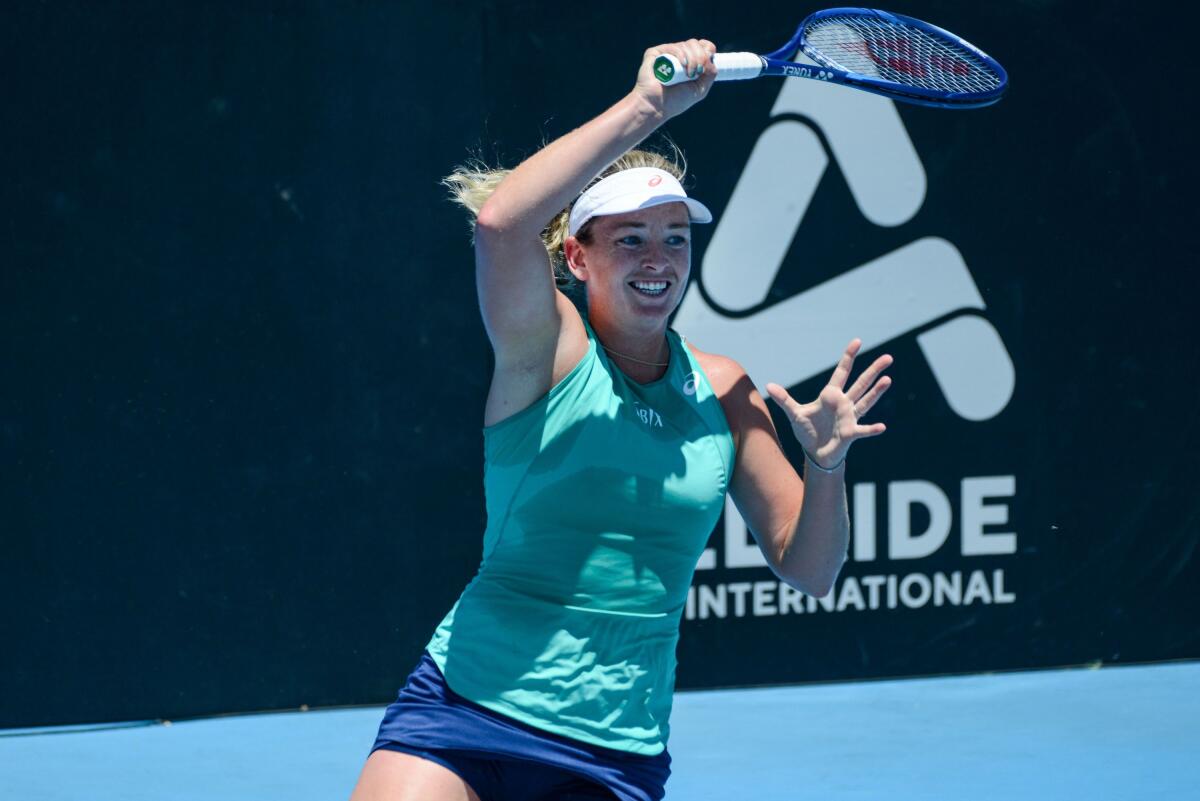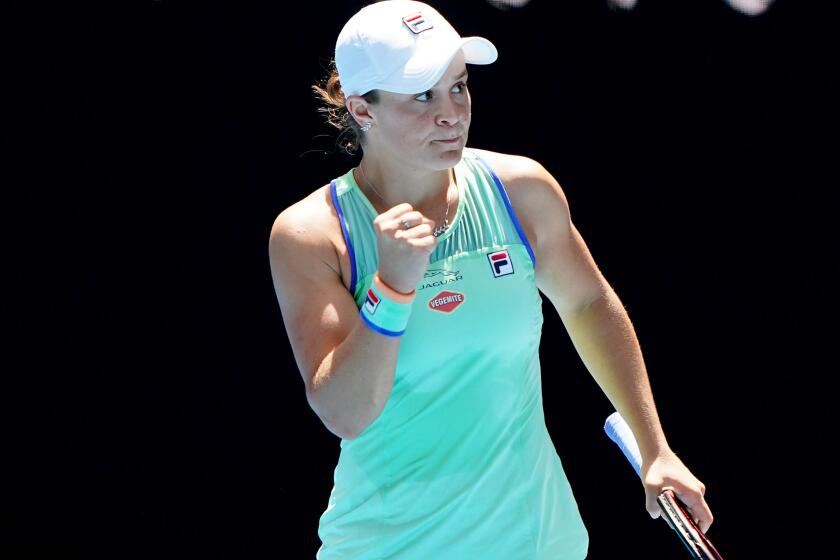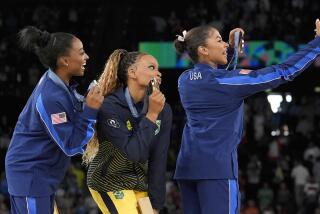Ailment meant CoCo Vandeweghe had to learn to walk before she ran back to tennis court

- Share via
When her central nervous system suddenly went haywire and a nerve disorder triggered pain in her right foot so intense that she couldn’t bear the touch of a finger or the tickle of a bed sheet against her skin, CoCo Vandeweghe was forced to reassess her tennis career and her life.
She became home-bound in San Diego, dependent on crutches. She had pushed through a nagging ankle injury she’d suffered at Wimbledon in 2018, but this was something else.
It was frightening.
“I considered quitting, stopping playing, because I didn’t know if I was going to be able to walk or run or do any of that again,” said Vandeweghe, a two-time Grand Slam singles semifinalist who reached a career-best No. 9 world ranking early in 2018. “And I thought to myself, ‘What am I going to do?’ ”
Rest was the only course after she was diagnosed with Complex Regional Pain Syndrome, a chronic condition that usually affects an arm or a leg after an injury. She also had to go through therapy that included desensitizing the top and bottom of her foot by rubbing textures such as sand or a towel against her skin.
The nerves gradually calmed down and two stress fractures in her leg knitted, but her healing had merely begun.
“I had to relearn how to walk, run, sprint, learn how to play tennis again a little bit,” she said. “With this ailment I would lose where my foot was just because not having used it for so long I don’t know where it was. It’s been a long road back.”
It’ll be the 50th meeting between No. 3 Roger Federer, who has won 20 Grand Slam titles, and No. 2 Novak Djokovic, who owns 16.
After playing strictly for fun, she decided to test herself at World Team Tennis. When that went well, she accepted a wild card from a tournament in San Jose in July — her first real matches in 10 months — and made it to the second round.
She’s still rebuilding her muscles, stamina, and a ranking that stood at 226 this week. After her first-round loss in the Australian Open, her next stop was the Oracle Challenger event at the Newport Beach Tennis Club, which runs through Sunday. Vandeweghe won her first two matches, including a 6-2, 6-1 victory over No. 10 seed Allie Kiick on Tuesday.
As in other small tournaments she has played recently, she played before crowds that numbered in the dozens instead of the thousands. That required an adjustment.
“It was definitely an ego check going back to Challengers because when I was injured I was top-10 in the world. I hadn’t played a Challenger in five, six years,” said Vandeweghe, who turned 28 in December. “There’s certain things you’re accustomed to. ... Simple things that you forget that can happen. Even something as trivial as — not at this tournament but at a different Challenger — I had to pick up my own balls because there were no ball kids, and I hadn’t done that in forever.
“It just kind of throws off your cadence. I can equate it to when you’re about to shoot a free throw and the ball’s at the baseline. You’ve just got to walk it back and start again. There’s no one tossing you the ball like a referee would. And it sounds like so dumb and trivial but it was like, gosh, ‘I forgot you have to do this.’”

The basketball analogy comes naturally to Vandeweghe. Her late grandfather, Dr. Ernie Vandeweghe, played six seasons for the New York Knicks and later became the Lakers’ team doctor.
Her uncle, Kiki VanDeWeghe led UCLA to the NCAA title game in 1980 and was a two-time All-Star in the NBA before he became a general manager and coach. He’s now executive vice president of basketball operations for the NBA.
In addition, her great-uncle Mel Hutchins played seven seasons in the NBA, her mother Tauna was a 1976 Olympic swimmer and a volleyball player at USC, and her aunt Heather was a national-level water polo player before becoming a doctor.
CoCo is a Knicks fan but also a Kobe Bryant fan, and she was stunned by his death in a helicopter crash Sunday. She met him when she was a kid and was thrilled when he tweeted his congratulations for her 2017 U.S. Open semifinal run.
“It’s crazy that someone, a hero of our generation has passed away before his time,” she said. “It’s definitely one of the first ones to have that kind of impact on everyone, to be a great player and to be taken away so quickly. I’ve talked with friends and they’ve said it feels like almost a president assassination that somebody has disappeared. … It’s weird to compress into words.
Ashleigh Barty is a step closer to ending a long Australian title drought at the national championships.
“And the things that he did for his daughter, and that includes helping women’s sports in general, when someone of that magnitude speaks out about women’s sports, people listen. It’s the way the world works.”
Vandeweghe has experienced some setbacks during her return but the journey has had its unexpected charms too, among them playing before passionate crowds in tournaments such as the Newport Beach Challenger event.
“When I was top-10 I was fighting for semifinals of Grand Slams and things like that, where here I am fighting to be back breaking back into the top 100, breaking back into my game,” she said. “Playing the way I want to play and enjoying the victory. Not enjoying the losses but enjoying being out there and doing it.
“So that side of it, five people, 5,000 it doesn’t matter to me. I’m out there to play for my own reasons and I always have. I’ve enjoyed big crowds and raucous crowds and things like that, and that’s always fun to play in, but also an intimate setting is very fun because you know the people are there to enjoy the tennis and not there for the show. It’s just a different atmosphere.
“It’s been fun coming back and playing again. It’s been a lot of hard work. Still is. And a lot of moments that I had forgotten what they felt like. I had forgotten what it was to face a break point, to serve out a match. The nerves that you feel when you walk out on the court. I’m still learning. I’m still getting used to it again, which is almost fun. Tennis can sometimes be a chore when I was playing day in and day out and to have it taken it away from me in a day, literally, I’m very grateful to be able to compete and play again, so I’m enjoying it all.”
More to Read
Go beyond the scoreboard
Get the latest on L.A.'s teams in the daily Sports Report newsletter.
You may occasionally receive promotional content from the Los Angeles Times.













